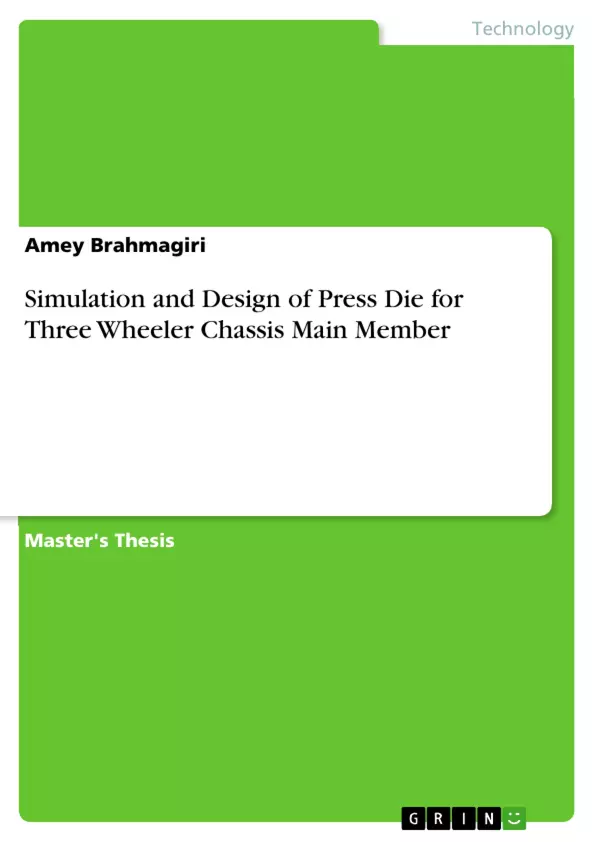Automobile industry is one of the fastest growing and largest consumer product sector. Many of the automobile parts are made up of sheet metal. The press forming is the most feasible and cost effective method for manufacturing the automotive body panels and other sheet metal parts. Though many new techniques such as reconfigurable dies for forming, incremental sheet forming offering better flexibility are developed, none of these modern techniques is capable for mass production as required in the industries.
The production of new stamping tools get more troublesome, as the geometries get more complex and smaller tolerances on the dimensions are requested. The design of dies is the most critical and important step in obtaining a dimensionally accurate and defect free product. The project consist of simulation, die design, optimization and die manufacturing assistance for a 3 wheeler chassis Main Member. The major difficulties like springback, twisting of part, insufficient stretching, wrinkles, cracks, stress concentrations and dimensional accuracy were successfully overcome in this project work.
The software tools which were used during this project are PAM-STAMP 2G for simulation and feasibility analysis, UG-NX (Modelling, Sheet metal & manufacturing modules) for modelling and creating CNC programs and Auto CAD for drafting.
Inhaltsverzeichnis (Table of Contents)
- Abstract
- Acknowledgement
- Symbols and glossary
- Introduction
- Overview
- Objectives of project
- Organization of the report
- Literature review
- Sheet metal forming
- Sheet metal forming process
- Hammering
- Multipoint forming
- Shot peen forming
- Lase forming
- Water jet forming
- Spinning process
- Incremental sheet forming
- Stamping
- Roll forming
- Hydroforming
- Sheet metal properties
- Anisotropy
- Strain hardening
- Strain rate sensitivity
- Young modulus
- Forming limit diagram
- Modes of deformation
- Sheet metal forming
- Die face design and simulation
- Methodology
- Material
- Die faced design
- Inverse simulation
- Forming simulation
- Phases in sheet metal forming
- Implicit and explicit solver
- Setting up simulation
- Results and discussion
- Results of inverse simulation
- Forming approaches
- Develop a SPM
- Use forming and restrike operation
- Use top and bottom blank holder
- Use draw operation
- Roll forming
- Increase the stroke
- Solution adapted
- Validation of results
- Conclusions
- References
Zielsetzung und Themenschwerpunkte (Objectives and Key Themes)
This dissertation focuses on the simulation, design, optimization, and manufacturing assistance for a 3-wheeler chassis main member. The primary goal is to overcome the challenges associated with complex geometries and stringent dimensional tolerances in the production of automotive sheet metal parts, particularly the chassis main member.
- Press die design and simulation for 3-wheeler chassis main member
- Overcoming challenges in sheet metal forming, such as springback, twisting, and dimensional accuracy
- Optimization of forming process parameters
- Integration of software tools for simulation and design
- Application of advanced forming techniques and analysis
Zusammenfassung der Kapitel (Chapter Summaries)
- Chapter 1: Introduction Provides an overview of the project, outlining its objectives and the organization of the report. It highlights the importance of sheet metal forming in the automotive industry and the challenges associated with achieving high-quality and dimensionally accurate components.
- Chapter 2: Literature Review This chapter delves into existing research on sheet metal forming processes, focusing on various methods and their limitations. It discusses key properties of sheet metal materials that influence the forming process, including anisotropy, strain hardening, and strain rate sensitivity.
- Chapter 3: Die Face Design and Simulation This chapter outlines the methodology used in die face design and the materials employed. It explores the concept of inverse simulation and its role in optimizing die geometry. The chapter then delves into the fundamentals of forming simulation, including phases of sheet metal forming, implicit and explicit solvers, and setting up simulation parameters.
- Chapter 4: Results and Discussion This chapter presents the results of the inverse simulation, focusing on the optimized die geometry. It explores various forming approaches, including different forming operations and strategies, and evaluates their effectiveness in achieving the desired part geometry and quality.
Schlüsselwörter (Keywords)
The key terms and concepts covered in this dissertation encompass sheet metal forming, press die design, simulation, optimization, automotive chassis main member, springback, twisting, dimensional accuracy, forming limits, material properties, and software tools such as PAM-STAMP 2G, UG-NX, and Auto CAD.
- Quote paper
- Amey Brahmagiri (Author), 2015, Simulation and Design of Press Die for Three Wheeler Chassis Main Member, Munich, GRIN Verlag, https://www.grin.com/document/346502



